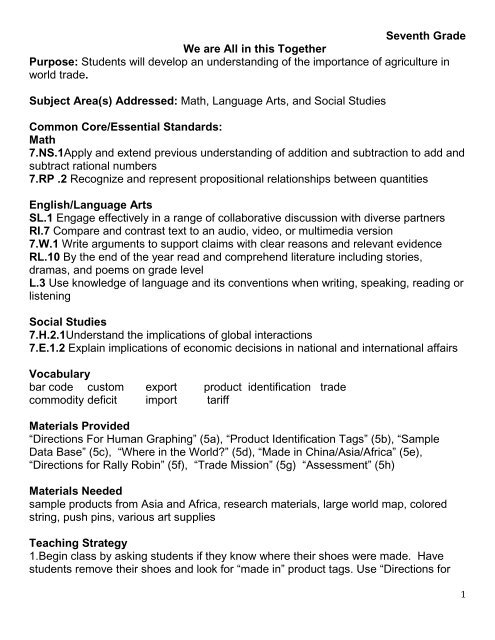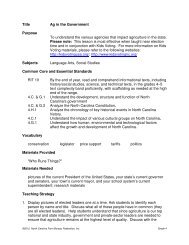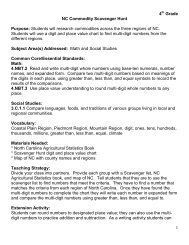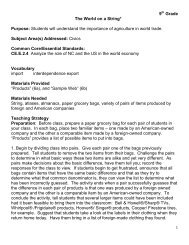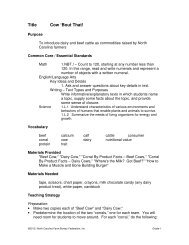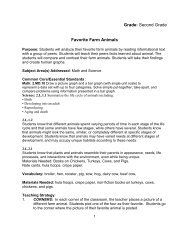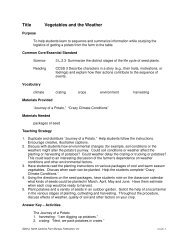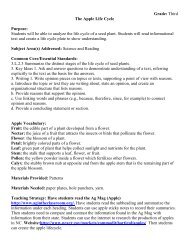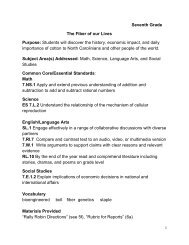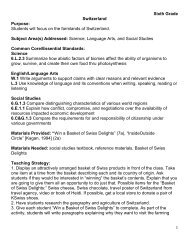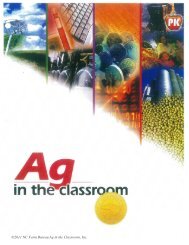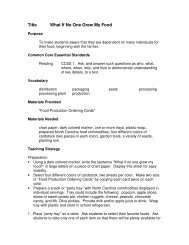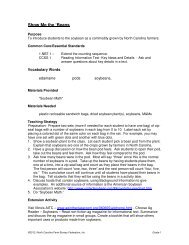Lesson Plan 10 – We are All in this Together - Ag in the Classroom
Lesson Plan 10 – We are All in this Together - Ag in the Classroom
Lesson Plan 10 – We are All in this Together - Ag in the Classroom
- No tags were found...
You also want an ePaper? Increase the reach of your titles
YUMPU automatically turns print PDFs into web optimized ePapers that Google loves.
Seventh Grade<strong>We</strong> <strong>are</strong> <strong>All</strong> <strong>in</strong> <strong>this</strong> <strong>Toge<strong>the</strong>r</strong>Purpose: Students will develop an understand<strong>in</strong>g of <strong>the</strong> importance of agriculture <strong>in</strong>world trade.Subject Area(s) Addressed: Math, Language Arts, and Social StudiesCommon Core/Essential Standards:Math7.NS.1Apply and extend previous understand<strong>in</strong>g of addition and subtraction to add andsubtract rational numbers7.RP .2 Recognize and represent propositional relationships between quantitiesEnglish/Language ArtsSL.1 Engage effectively <strong>in</strong> a range of collaborative discussion with diverse partnersRI.7 Comp<strong>are</strong> and contrast text to an audio, video, or multimedia version7.W.1 Write arguments to support claims with clear reasons and relevant evidenceRL.<strong>10</strong> By <strong>the</strong> end of <strong>the</strong> year read and comprehend literature <strong>in</strong>clud<strong>in</strong>g stories,dramas, and poems on grade levelL.3 Use knowledge of language and its conventions when writ<strong>in</strong>g, speak<strong>in</strong>g, read<strong>in</strong>g orlisten<strong>in</strong>gSocial Studies7.H.2.1Understand <strong>the</strong> implications of global <strong>in</strong>teractions7.E.1.2 Expla<strong>in</strong> implications of economic decisions <strong>in</strong> national and <strong>in</strong>ternational affairsVocabularybar code custom export product identification tradecommodity deficit import tariffMaterials Provided“Directions For Human Graph<strong>in</strong>g” (5a), “Product Identification Tags” (5b), “SampleData Base” (5c), “Where <strong>in</strong> <strong>the</strong> World?” (5d), “Made <strong>in</strong> Ch<strong>in</strong>a/Asia/Africa” (5e),“Directions for Rally Rob<strong>in</strong>” (5f), “Trade Mission” (5g) “Assessment” (5h)Materials Neededsample products from Asia and Africa, research materials, large world map, coloredstr<strong>in</strong>g, push p<strong>in</strong>s, various art suppliesTeach<strong>in</strong>g Strategy1.Beg<strong>in</strong> class by ask<strong>in</strong>g students if <strong>the</strong>y know where <strong>the</strong>ir shoes were made. Havestudents remove <strong>the</strong>ir shoes and look for “made <strong>in</strong>” product tags. Use “Directions for1
Human Graph” and have students make a human graph by stand<strong>in</strong>g <strong>in</strong> l<strong>in</strong>e by countryof shoe orig<strong>in</strong>. Ask students if <strong>the</strong>y were surprised by <strong>the</strong> results. Discuss withstudents o<strong>the</strong>r items <strong>the</strong>y use daily and have <strong>the</strong> class predict where those items weremade. List items and predictions on board. Keep <strong>this</strong> list as a reference.2. Reproduce “Product Identification Tags,” us<strong>in</strong>g bright colors to represent eachproduct type. Assign students “Product Identification Tags" for homework. Expla<strong>in</strong> to<strong>the</strong> students that <strong>the</strong>y will have to decide <strong>the</strong> product type of <strong>the</strong> article <strong>the</strong>y <strong>are</strong>tagg<strong>in</strong>g. They will need to note <strong>the</strong> country of orig<strong>in</strong> and write a brief description of <strong>the</strong>article. The completed tags <strong>are</strong> to be returned to class. Give <strong>the</strong> students examples ofeach category. Encourage <strong>the</strong> students to f<strong>in</strong>d as many different items from as manydifferent countries as possible.3. When students return <strong>the</strong>ir tags to class, create a class graph by plac<strong>in</strong>g tags on abullet<strong>in</strong> board by country. Discuss results with <strong>the</strong> students. If more than one class isdo<strong>in</strong>g <strong>the</strong> activity, have students comp<strong>are</strong> <strong>the</strong> results and draw conclusions.4. Have students identify <strong>the</strong> products that were made from agricultural commodities.5. Have students enter <strong>the</strong>se <strong>in</strong> a class data base. Use “Sample Data Base” as anexample.6. Have <strong>the</strong> class use <strong>the</strong> class data base to graph <strong>the</strong> results by country.Comp<strong>are</strong> <strong>the</strong> graphs. Discuss world trade agreements and how <strong>the</strong>y affect each of us.Divide <strong>the</strong> class <strong>in</strong>to teams and assign each team an item or class of items to researchus<strong>in</strong>g “Where <strong>in</strong> <strong>the</strong> World ?”7. Have students use “Made <strong>in</strong> Ch<strong>in</strong>a/Asia/Africa” to create a map of <strong>the</strong>ir productsshow<strong>in</strong>g a world trade map. Use different colors of str<strong>in</strong>g for each major class ofproducts. Discuss with students regional <strong>in</strong>terdependence and identify goods <strong>the</strong> U.S.produces and trades. Locate major manufactur<strong>in</strong>g centers <strong>in</strong> <strong>the</strong> U.S. Us<strong>in</strong>g “DirectionsFor Rally Rob<strong>in</strong>,” have students describe how economic l<strong>in</strong>ks make Americans andpeople from o<strong>the</strong>r countries more alike <strong>in</strong> <strong>the</strong> goods <strong>the</strong>y use. An example would bemusic. There is a big Asian market for American music.8. Ask students to sh<strong>are</strong> what <strong>the</strong>y know about <strong>the</strong> economies of <strong>the</strong> countriesidentified <strong>in</strong> <strong>the</strong> previous activities. Expla<strong>in</strong> that one way countries <strong>in</strong>crease <strong>the</strong>irexports is by arrang<strong>in</strong>g trade missions to o<strong>the</strong>r nations. Trade missions may be madeup of both bus<strong>in</strong>ess people and government officials <strong>in</strong>terested <strong>in</strong> promot<strong>in</strong>g trade.9. Discuss United States’ trade missions with <strong>the</strong> students. Expla<strong>in</strong> to <strong>the</strong> students that<strong>the</strong>y will be on simulated trade missions represent<strong>in</strong>g <strong>the</strong> countries <strong>the</strong>y have beenwork<strong>in</strong>g with <strong>in</strong> <strong>the</strong> product mapp<strong>in</strong>g activities.<strong>10</strong>. Divide students <strong>in</strong>to teams, one team for each country. Assign each team ofstudents a country. Expla<strong>in</strong> that each team is to take part <strong>in</strong> a trade mission to promoteits country's products. Teams will use “Trade Mission” to complete <strong>the</strong> activity.11. After teams have presented <strong>the</strong>ir research projects to <strong>the</strong> class, use “Assessment”to determ<strong>in</strong>e <strong>the</strong> success of student endeavors.2
Extension Activities1. Have a guest speaker from <strong>the</strong> Department of Commerce speak to <strong>the</strong> class aboutforeign and domestic trade.2. Take a class field trip to a w<strong>are</strong>house distributor to observe how goods <strong>are</strong> receivedand distributed.Directions for Human Graph<strong>in</strong>gBar Graph: Have one student <strong>in</strong> each group hold that group’s identify<strong>in</strong>g word orpicture and <strong>the</strong> o<strong>the</strong>rs <strong>in</strong> that group form a l<strong>in</strong>e beh<strong>in</strong>d <strong>the</strong> person hold<strong>in</strong>g <strong>the</strong> word orpicture. The last person <strong>in</strong> l<strong>in</strong>e will have his or her back aga<strong>in</strong>st <strong>the</strong> wall; <strong>the</strong> o<strong>the</strong>rgroup members will l<strong>in</strong>e up one-by-one, fac<strong>in</strong>g away from <strong>the</strong> wall, with <strong>the</strong> person <strong>in</strong><strong>the</strong> front of <strong>the</strong> l<strong>in</strong>e hold<strong>in</strong>g <strong>the</strong> word or picture. Have <strong>the</strong> o<strong>the</strong>r groups form l<strong>in</strong>es <strong>in</strong> <strong>the</strong>same manner along <strong>the</strong> same wall. See diagram for a graphic representation of <strong>the</strong>formation of l<strong>in</strong>es.Expla<strong>in</strong> that <strong>the</strong> class has created a bar graph that expresses students’ preferences.Po<strong>in</strong>t out that a graph is a picture that represents facts for <strong>the</strong> viewer to make logical<strong>in</strong>ferences.L<strong>in</strong>e Graph: Hand <strong>the</strong> first person <strong>in</strong> <strong>the</strong> first row <strong>the</strong> end of a ball of str<strong>in</strong>g or roll ofcrepe paper. Walk<strong>in</strong>g <strong>in</strong> front of each row, have <strong>the</strong> first person take hold of <strong>the</strong> str<strong>in</strong>gor paper, end<strong>in</strong>g with <strong>the</strong> person at <strong>the</strong> front of <strong>the</strong> last row. Ask <strong>the</strong> class what graph<strong>the</strong>y have now formed: a l<strong>in</strong>e graph. Make sure students understand that <strong>the</strong> bargraph and l<strong>in</strong>e graph both represent <strong>the</strong> same <strong>in</strong>formation; however, a l<strong>in</strong>e graphshows trends and changes over time.3
Pie/Circle Graph: Have students <strong>in</strong> each l<strong>in</strong>e jo<strong>in</strong> hands. Form a circle beg<strong>in</strong>n<strong>in</strong>g with<strong>the</strong> students <strong>in</strong> <strong>the</strong> first l<strong>in</strong>e. As <strong>the</strong> teacher marches <strong>in</strong> a circle <strong>the</strong> students <strong>in</strong> eachl<strong>in</strong>e take <strong>the</strong> hand of <strong>the</strong> last person <strong>in</strong> <strong>the</strong> l<strong>in</strong>e ahead of <strong>the</strong>m. Once all groups/l<strong>in</strong>es<strong>are</strong> <strong>in</strong> <strong>the</strong> full circle, have students drop <strong>the</strong>ir hands. The person hold<strong>in</strong>g <strong>the</strong>word/picture lays is on <strong>the</strong> floor <strong>in</strong> <strong>the</strong> middle of <strong>the</strong>ir group such that everyone <strong>in</strong> <strong>the</strong>circle can see it. The teacher moves to <strong>the</strong> center of <strong>the</strong> circle hold<strong>in</strong>g pieces of str<strong>in</strong>gor crepe paper. The first person <strong>in</strong> each group goes to <strong>the</strong> teacher and takes <strong>the</strong> endof one piece of str<strong>in</strong>g/paper and <strong>the</strong>n returns to his/her place <strong>in</strong> <strong>the</strong> circle. Seediagram for visual understand<strong>in</strong>g:Clarify with class that each of <strong>the</strong> graphs created represents <strong>the</strong> same f<strong>in</strong>d<strong>in</strong>gs; <strong>the</strong>se<strong>are</strong> merely three different methods to depict that data. A follow up lesson with graphson paper and/or computer will help re<strong>in</strong>force student understand<strong>in</strong>g.*Adapted with permission from Kagan Publish<strong>in</strong>g from Dr. Spencer Kagan’s BookCooperative Learn<strong>in</strong>g. Available from Kagan Publish<strong>in</strong>g, 1 (800) WEE CO-OP,www.KaganOnl<strong>in</strong>e.com4
Product Identification Tags5
Sample Data Base7
Where <strong>in</strong> <strong>the</strong> World?DirectionsUs<strong>in</strong>g <strong>the</strong> item your team chose or given, complete <strong>the</strong> follow<strong>in</strong>g and compile <strong>the</strong>results <strong>in</strong> a work product you will use to convey <strong>the</strong> <strong>in</strong>formation to your classmates.Your work product should have <strong>the</strong> follow<strong>in</strong>g:1. maps2. graphs3. description of work4. summary1. Provide a brief description of <strong>the</strong> item.2. Where was <strong>the</strong> item made?3. Locate country of orig<strong>in</strong> on a world map.4. Give <strong>the</strong> geographic coord<strong>in</strong>ates of <strong>the</strong> country.5. Trace <strong>the</strong> route <strong>the</strong> item followed to arrive at <strong>the</strong> retail store where <strong>the</strong> item waspurchased.6. What raw materials went <strong>in</strong>to <strong>the</strong> production of <strong>the</strong> item?7. How many hours of labor were <strong>in</strong>volved?8. How many o<strong>the</strong>r people were <strong>in</strong>volved <strong>in</strong> <strong>the</strong> transportation and movement of <strong>the</strong>product from <strong>the</strong> country of orig<strong>in</strong> to <strong>the</strong> store where <strong>the</strong> item was purchased?9. Estimate <strong>the</strong> number of jobs and amount of money generated by <strong>this</strong> onepurchase.<strong>10</strong>. Is <strong>the</strong> country of orig<strong>in</strong> a third world country?11. What is <strong>the</strong> standard of liv<strong>in</strong>g <strong>the</strong>re?12. What determ<strong>in</strong>es a standard of liv<strong>in</strong>g?13. Comp<strong>are</strong> <strong>the</strong> country’s standard of liv<strong>in</strong>g to your state’s standard of liv<strong>in</strong>g.14. Does <strong>the</strong> U.S. have a trade agreement with <strong>the</strong> country of orig<strong>in</strong>?15. How do trade agreements affect <strong>the</strong> average American consumer?8
Made <strong>in</strong> Ch<strong>in</strong>a/Asia/AfricaDirections:Us<strong>in</strong>g your product(s) from “Where <strong>in</strong> <strong>the</strong> World?” complete <strong>the</strong> map activity below.1. F<strong>in</strong>d <strong>the</strong> manufacturer's label on your product(s).2. Record where each product is made.3. Locate each country on a world map.4. P<strong>in</strong> a str<strong>in</strong>g from your state or city to <strong>the</strong> manufactur<strong>in</strong>g country.5. Hang a symbol for each product on <strong>the</strong> str<strong>in</strong>g to <strong>in</strong>dicate category of trade.Example: agricultural product, <strong>in</strong>dustrial product.9
Directions for Rally Rob<strong>in</strong>*1. Group students - teams of 4.2. Have students number off from 1 to 4 <strong>in</strong> <strong>the</strong>ir team. Team members will alternateshar<strong>in</strong>g what <strong>the</strong>y have on <strong>the</strong>ir papers <strong>in</strong> <strong>the</strong> follow<strong>in</strong>g manner:a. Team member #1 reads one idea. <strong>All</strong> o<strong>the</strong>rs ei<strong>the</strong>r check <strong>the</strong> idea if <strong>the</strong>y have italso or add it to <strong>the</strong>ir lists if <strong>the</strong>y do not.b. Team members <strong>the</strong>n cont<strong>in</strong>ue to take turns (Team member #1 sh<strong>are</strong>s, Teammember #2 sh<strong>are</strong>s, Team member #3 sh<strong>are</strong>s, Team member #4 sh<strong>are</strong>s, Teammember #1 sh<strong>are</strong>s, etc.) - shar<strong>in</strong>g until all new ideas have been read and added to<strong>the</strong>ir lists.NOTE: The list for each team member should have <strong>the</strong> same items when <strong>the</strong> activity iscompleted.3. Have all teams stand for class shar<strong>in</strong>g session. This will be done <strong>in</strong> <strong>the</strong> follow<strong>in</strong>gmanner.a. Team member 1 on each team has <strong>the</strong> team list. The teacher randomly calls outteam number. Team member #1 reads <strong>the</strong> first item on his or her list.b. Team members #1 <strong>in</strong> <strong>the</strong> o<strong>the</strong>r teams ei<strong>the</strong>r check <strong>the</strong> item, if <strong>the</strong>y have <strong>the</strong>same item, or add it to <strong>the</strong>ir lists if <strong>the</strong>y do not.c. In each team, Team member #1 hands his or her list to number two.d. The teacher calls <strong>the</strong> number of ano<strong>the</strong>r team. Team member #2 reads adifferent item from <strong>the</strong> one previously sh<strong>are</strong>d. Team members #2 <strong>in</strong> <strong>the</strong> o<strong>the</strong>r teamscheck or add.e. Team members #2 hands lists to Team members #2 and <strong>this</strong> cont<strong>in</strong>ues until allitems have been read and checked. As a team’s list no longer has additional items, allteam members sit down, but cont<strong>in</strong>ue to add new items sh<strong>are</strong>d to its list.f. When all teams <strong>are</strong> seated, each list should conta<strong>in</strong> all <strong>the</strong> same items. This is agood time for <strong>the</strong> teacher to provide clarification and re<strong>in</strong>forcement.*Adapted with permission from Kagan Publish<strong>in</strong>g from Dr. Spencer Kagan’s BookCooperative Learn<strong>in</strong>g. Available from Kagan Publish<strong>in</strong>g, 1 (800) WEE CO-OP,www.KaganOnl<strong>in</strong>e.com.<strong>10</strong>
Trade MissionDirections:You have been assigned a country to establish a trade mission. Use__________________(Your country’s name) and <strong>the</strong> <strong>in</strong>formation from your research to complete <strong>the</strong>follow<strong>in</strong>g statements.1. What products <strong>are</strong> ______________ ‘s major exports to o<strong>the</strong>r countries?(your country’s name)2. Research <strong>the</strong> history and economy of ________________________.(your country’s name)3. Present that <strong>in</strong>formation <strong>in</strong> <strong>in</strong>formative and persuasive brochures orhandouts. The <strong>in</strong>formation presented should <strong>in</strong>clude such facts as:a. Depend<strong>in</strong>g on geography,how would <strong>the</strong> product best be transported to o<strong>the</strong>rcountries (for example by tanker, tra<strong>in</strong>, truck, or plane)b. In what quantities is <strong>the</strong> product normally sold (for example, by tonnage)?c. If <strong>the</strong> product is produced, what time of <strong>the</strong> year would it be ready for shipp<strong>in</strong>g?d. Show current production figures, presented <strong>in</strong> tables and/or graphs.e. Develop a brochure to advertise. Use representative scenes to illustrate <strong>the</strong>brochures.f. Schedule meet<strong>in</strong>gs with <strong>the</strong> representatives of all <strong>the</strong> o<strong>the</strong>r countries to makepresentations.g. Work out trade deals that <strong>are</strong> mutually beneficial.h. Present a written summary of what has been accomplished.i. Create a bullet<strong>in</strong> board display of your work. The display should <strong>in</strong>clude aproduct map of <strong>the</strong> country as well as <strong>the</strong> brochures and handouts.4. Research which products from_________________ <strong>are</strong> imported to <strong>the</strong> UnitedStates and North Carol<strong>in</strong>a. (your country’s name)5. Create tables and/or graphs to <strong>in</strong>dicate annual totals.6. Make a comparison of two countries that export similar products to <strong>the</strong> UnitedStates. Use a double bar graph to show which country sells more of eachproduct.11
7. Use a product map of _________________ to plan a guided tour for a trademission on a fact- (your country’s name) f<strong>in</strong>d<strong>in</strong>g tour. The route should showwhich sites would be most impressive (for example, major <strong>in</strong>dustrial <strong>are</strong>as, fertileagricultural regions, bustl<strong>in</strong>g and efficient ports).Assessment1. Did students learn to locate data regard<strong>in</strong>g country of orig<strong>in</strong>?2. Did students follow directions when compil<strong>in</strong>g data?3. <strong>We</strong>re students able to graph result<strong>in</strong>g <strong>in</strong>formation?4. <strong>We</strong>re students able to read graphs and charts and to <strong>in</strong>terpret data <strong>in</strong>volved?5. <strong>We</strong>re students able to locate countries on maps?6. <strong>We</strong>re students able to draw <strong>the</strong>ir own maps and show desired <strong>in</strong>formation on <strong>the</strong>maps?7. <strong>We</strong>re students able to draw conclusions from <strong>in</strong>formation located?8. <strong>We</strong>re <strong>the</strong> students able to summarize <strong>the</strong> <strong>in</strong>formation and communicate <strong>the</strong><strong>in</strong>formation to o<strong>the</strong>rs?9. Was student <strong>in</strong>formation correct?<strong>10</strong>. <strong>We</strong>re student work products neat and attractive?11. Did all students work on <strong>the</strong> f<strong>in</strong>ished product?12. <strong>We</strong>re students able to work as a group successfully?12


